
Human-Equine Interaction
Human-equine relationships date back an estimated 4000-6000 years with initial domestication as pack animals and livestock (Goodwin, 2003; Kelly et al., 2021). Horses were quickly integrated into several other working roles still relevant today, including transportation, farm work, hunting, and recreation (Hausberger et al., 2008). During this process, horses came to be viewed as more than “tools” and today many people value the companionship and partnership they receive from horses (Keaveney, 2008). The health benefits of interacting with horses was recognized as early as the 6th century and research has shown that human-equine interactions convey psychosocial benefits such as reduction of depression, fatigue, hyperactivity, and irritability, and increases in self-esteem, empathy, and emotional, social and behavioral functioning; physical benefits include increased physical activity and improvements to balance, gait, gross motor function, and posture (Fine & Anderson, 2021).
Equine-assisted services are a category of interventions that intentionally incorporate horses for the betterment of human health and wellbeing. These interventions can be divided into 3 categories: horsemanship, learning or therapy (Wood et al., 2021). The horsemanship category encompasses interventions that teach traditional interactions with horses such as riding or driving. The learning category encompasses interventions that focus on education, personal development or organizational development. The therapy category is facilitated by a licensed therapist in their own scope of practice (e.g., psychotherapy incorporating horses, physical therapy in an equine environment). Considering the popularity of equine assisted services and the dependence of humans and horses on one another for health, companionship, and support, it is crucial to understand the effects of human-equine interactions.
In the HAPI lab within the Center for the Human-Animal Bond, our research uses a biopsychosocial approach to understand human-equine interactions, and to support the development of practical and effective interventions for the benefit of both humans and horses. Of particular interest are the effects and outcomes of equine-assisted services for military-connected individuals and emergency responders. The HAPI lab partners with several providers of equine-assisted services to understand these real-life impacts. Additionally, the HAPI lab studies the effects of human-equine interactions in a number of contexts including for safe and beneficial horsemanship, as a therapeutic intervention, and as companions.
Our Research

Show full text description
Diversity, Equity, Inclusion, and Belonging in Equine-Assisted Services
Overview
This study explores how diversity, equity, inclusion, and belonging (DEIB) principles are expressed and experienced within the field of equine-assisted services (EAS). Researchers describe EAS as a microcosm of non-traditional education, where learning happens through both human and animal relationships.
Participants and Methods
- 11 clinicians and practitioners were interviewed about their professional experiences.
- Interviews were analyzed using a Participatory Action Framework and Thematic Analysis.
Key Themes Identified
- Identity and Self-Relation with Horses – Understanding one’s sense of self through interactions with horses.
- Awareness of Scope of Practice – Recognizing one’s professional limits, responsibilities, and areas of growth.
- Being in Relationship – Emphasizing mutual respect, empathy, and connection in human–horse and human–human interactions.
The findings suggest that EAS environments can foster reflection on personal and social identity, as well as encourage inclusive practices within therapeutic and educational settings.
Vincent, A., Nieforth, L.O., Dayle John, K. & Schafroth, J. (2025). Diversity, Equity, Inclusion & Belonging in EAS: a microcosm of non-traditional education. Human-Animal Interactions. doi:10.1079/hai.2025.0028
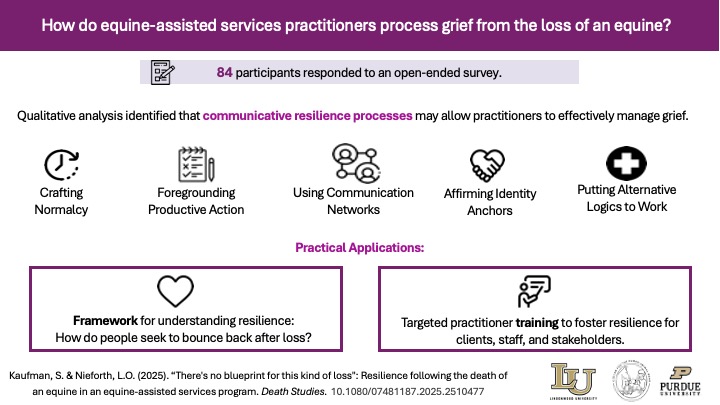
Show full text description
How Do Equine-Assisted Services Practitioners Process Grief from the Loss of an Equine?
Overview
This study examines how equine-assisted services (EAS) practitioners experience and process grief following the loss of an equine partner. Responses from 84 participants were analyzed using a qualitative framework to understand resilience and adaptation.
Key Findings
Researchers identified that communicative resilience processes may help practitioners effectively manage grief and continue their professional practice. These processes include:
- Crafting normalcy – Establishing routines to regain a sense of normal life and work.
- Foregrounding productive action – Channeling emotions into purposeful or constructive activities.
- Using communication networks – Seeking connection, support, and shared understanding within peer communities.
- Affirming identity anchors – Reconnecting with one’s role, values, or sense of purpose after loss.
- Putting alternative logics to work – Reframing or finding new meaning in the loss experience.
Practical Applications
- Framework for understanding resilience: Helps explain how people recover and find stability after loss.
- Targeted practitioner training: Supports resilience-building among clients, staff, and stakeholders within equine-assisted services programs.
The study underscores that grief in EAS contexts involves both emotional and professional dimensions, and that communication-centered resilience strategies can facilitate healing and adaptation.
Kaufman, S. & Nieforth, L.O. (2025). "There's no blueprint for this kind of loss": Resilience following the death of an equine in an equine-assisted services program. Death Studies. doi:10.1080/07481187.2025.2510477
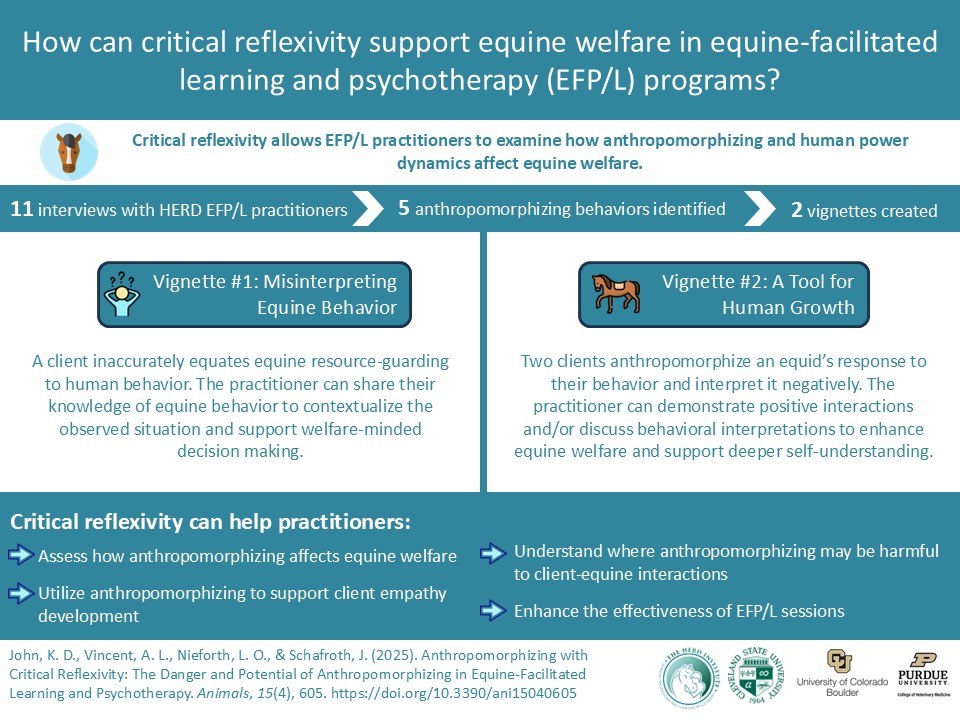
Show full text description
How Can Critical Reflexivity Support Equine Welfare in Equine-Facilitated Learning and Psychotherapy (EFP/L) Programs?
Overview
This study explores how critical reflexivity allows EFP/L practitioners to examine how anthropomorphizing and human power dynamics influence equine welfare. The goal is to support more ethical, welfare-minded practice within equine-facilitated programs.
Methodology
- 11 interviews conducted with HERD EFP/L practitioners
- 5 anthropomorphizing behaviors identified
- 2 vignettes developed to illustrate key findings
Vignettes
Vignette #1: Misinterpreting Equine Behavior
A client inaccurately equates equine resource-guarding to human behavior. The practitioner uses their knowledge of equine behavior to contextualize the situation and guide welfare-centered decision making.
Vignette #2: A Tool for Human Growth
Two clients anthropomorphize an equid’s response and interpret it negatively. The practitioner reframes the interaction to demonstrate positive engagement, highlighting how understanding equine behavior can support both welfare and client self-awareness.
Applications of Critical Reflexivity
- Assess how anthropomorphizing affects equine welfare
- Use anthropomorphizing to support client empathy development
- Recognize when anthropomorphizing may harm client–equine interactions
- Enhance the overall effectiveness of EFP/L sessions
This work demonstrates that reflective practice helps equine professionals balance human emotional needs with equine welfare, promoting ethical and effective therapeutic outcomes.
John, K. D., Vincent, A. L., Nieforth, L. O., & Schafroth, J. (2025). Anthropomorphizing with Critical Reflexivity: The Danger and Potential of Anthropomorphizing in Equine-Facilitated Learning and Psychotherapy. Animals, 15(4), 605. doi:10.3390/ani15040605
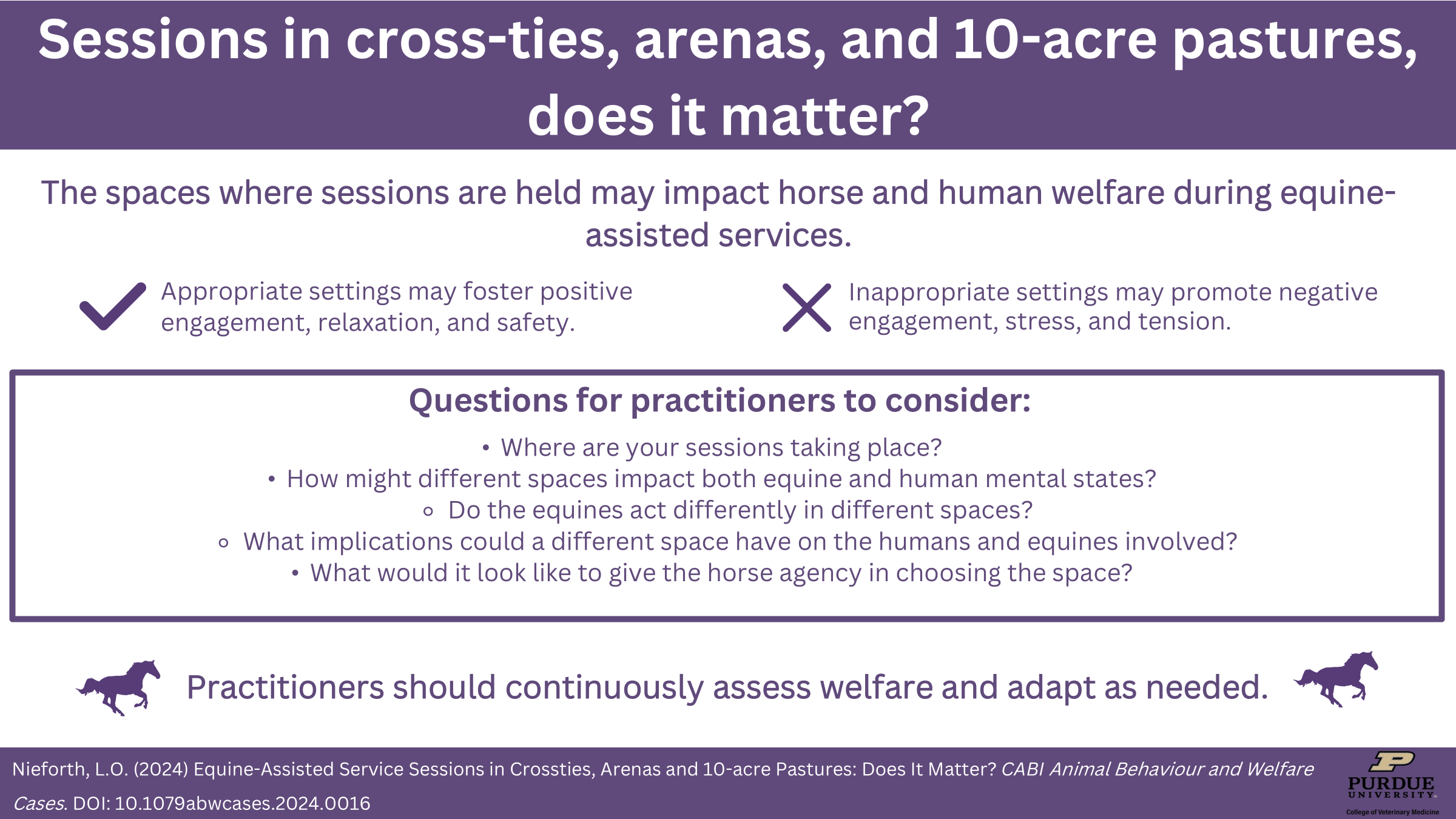
Show full text description
Sessions in Cross-Ties, Arenas, and 10-Acre Pastures — Does It Matter?
Overview
This case study explores how the physical spaces used for equine-assisted services can influence the welfare and engagement of both horses and humans. The research emphasizes that session environments play a key role in shaping comfort, safety, and connection.
Key Insights
- Appropriate settings may foster positive engagement, relaxation, and safety.
- Inappropriate settings may contribute to stress, tension, or disengagement.
Questions for Practitioners to Consider
- Where are your sessions taking place?
- How might different spaces impact both equine and human mental states?
- Do equines behave differently in different settings?
- What implications might different spaces have on the humans and equines involved?
- What would it look like to give the horse agency in choosing the space?
Practitioners are encouraged to continuously assess welfare and adapt their session environments as needed to ensure optimal outcomes for all participants.
Nieforth, L.O.. Equine-Assisted Service Sessions in Crossties, Arenas and 10-acre Pastures: Does It Matter? (2024). CABI Animal Behaviour and Welfare Cases. doi:10.1079abwcases.2024.0016

Show full text description
How Do Practitioners Experience the Death of an Equine in Equine-Assisted Services?
Overview
This study explores how equine-assisted service (EAS) practitioners experience and process the death of an equine partner. A total of 84 practitioners completed an online survey, and their open-ended responses were qualitatively analyzed to identify key themes related to grief and program impact.
Themes Identified
1. Processing the Death of an Equine
Practitioners’ experiences aligned with Worden’s Four Tasks of Mourning (2018):
- Accepting the reality of the loss
- Processing the pain of grief
- Adjusting to an environment where the deceased is missing
- Emotionally relocating the deceased to move on with life
2. Practical Implications
The death of an equine can have profound effects on EAS programs, clients, and staff. Planning ahead may help reduce distress and maintain program stability. Practitioners are encouraged to:
- Consider the logistics of death (e.g., burial or remains management)
- Plan for euthanasia with attention to appropriate timing and welfare
- Develop a communication plan for sharing the news with staff, clients, and volunteers
The study highlights the emotional depth of human–equine relationships in therapeutic contexts and underscores the need for structured grief support and program-level preparedness.
Nieforth, L.O. & Kaufman, S. (2024). Practitioner experiences of the death of a horse in an equine-assisted services program. OMEGA: Journal of Death and Dying. doi:10.1177/00302228241249200
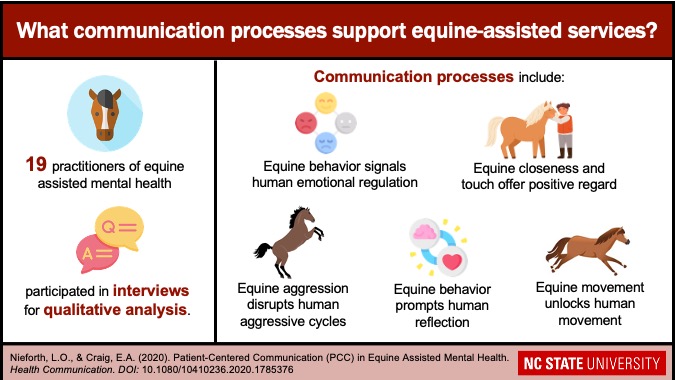
Show full text description
What Communication Processes Support Equine-Assisted Services?
Overview
This study investigates how communication occurs within equine-assisted mental health services. 19 practitioners participated in in-depth interviews, and their responses were analyzed qualitatively to identify communication processes that enhance therapeutic outcomes.
Key Communication Processes Identified
- Equine behavior signals human emotional regulation – Horses’ reactions provide feedback that helps clients manage emotions.
- Equine closeness and touch offer positive regard – Physical proximity and touch foster trust and connection.
- Equine aggression disrupts human aggressive cycles – Horses’ defensive responses may prompt self-awareness in clients.
- Equine behavior prompts human reflection – Interactions encourage clients to interpret and reconsider their behaviors.
- Equine movement unlocks human movement – Physical interaction and mirroring can facilitate emotional and bodily release.
The findings emphasize that communication in equine-assisted therapy is bidirectional — both horse and human exchange cues that shape emotional understanding, trust, and therapeutic progress.
Nieforth, L., Craig, E. (2020). Patient-centered communication (PCC) in equine assisted mental health. Health Communication. doi:10.1080/10410236.2020.1785376
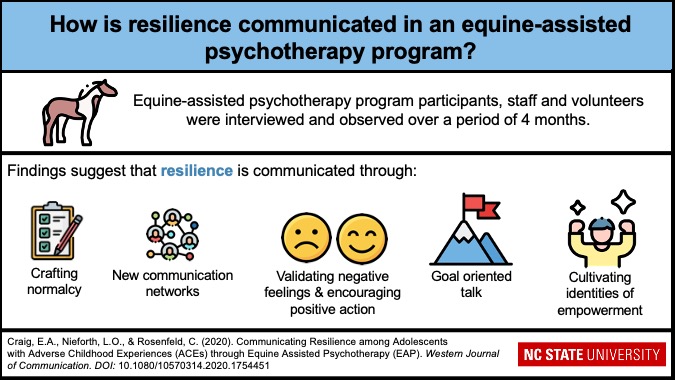
Show full text description
How Is Resilience Communicated in an Equine-Assisted Psychotherapy Program?
Overview
This qualitative study examined how resilience is expressed and communicated within an equine-assisted psychotherapy program. Over a 4-month period, researchers conducted interviews and observations with program participants, staff, and volunteers to explore patterns of communication that support emotional healing and growth.
Key Findings
The research suggests that resilience is communicated through the following processes:
- Crafting normalcy – Establishing stable routines that foster safety and predictability.
- New communication networks – Building supportive interpersonal relationships among participants and facilitators.
- Validating negative feelings and encouraging positive action – Acknowledging emotional challenges while motivating adaptive responses.
- Goal-oriented talk – Using purposeful dialogue to promote hope and forward momentum.
- Cultivating identities of empowerment – Encouraging participants to view themselves as capable and resilient individuals.
These findings highlight how equine-assisted psychotherapy programs provide a communicative environment that nurtures personal resilience, community connection, and emotional well-being through interaction and reflection.
Craig, E., Nieforth, L., & Rosenfeld, C. (2020). Communicating resilience among adolescents with adverse childhood experiences (ACEs) through equine assisted psychotherapy (EAP). Western Communication. doi:10.1080/10570314.2020.1754451

